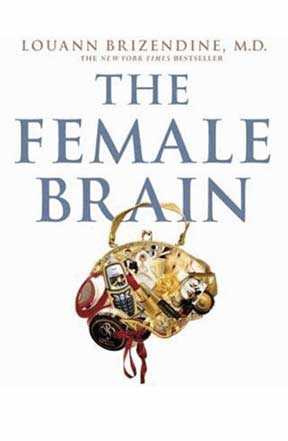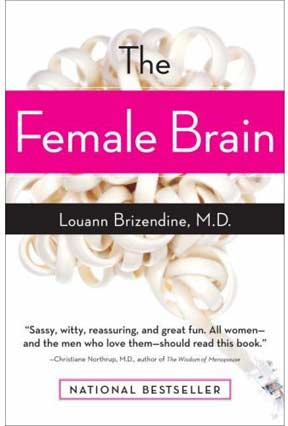Language Log notes that the British softcover edition of Louann Brizendine’s The Female Brain is out, and the cover art differs significantly from the US hardcover edition. Such differences are not unusual, but what is interesting here is the change in the implied message of the cover:


The American cover represents the female brain as a tangled phone cord, clearly implying communication, which is a theme of the book (though arguably a tangled and outdated analog communication?) The new British cover depicts a purse jam-packed with cosmetics and accessories, implying. . . superficiality? A cell phone (about to be clobbered by an open lipstick – handbag disaster in progress!) references the communications theme, but overall, the bursting purse barely resembles a brain to me, and certainly not MY brain. I thought the phone cord was clearly brain-shaped, elegant and serious in its cream-on-white aesthetic. The British version is flashy, pink, and disorganized – kind of a Bridget Jones’ Brain.
So is the book’s content serious, or is it chick-lit? I’m not sure, because I haven’t had time to read it yet, but I’m anxious to get to it because some of the reviews are troubling. This is a book that claims to out the gender differences we all suspect are there, but don’t always like to acknowledge. As David Brooks put it in the NYT,
These sorts of stark sex differences were once highly controversial, and not fit for polite conversation. And some feminists still argue that talking about biological differences between the sexes is akin to talking about biological differences between the races. But Brizendine’s feminist bona fides are unquestionable. And in my mostly liberal urban circle — and among this book’s reviewers — almost everybody takes big biological differences as a matter of course.
I’m one of those who suspect significant neurological differences do exist between the genders, so I can’t criticize Brizendine for calling attention to them. But I’m not sure exactly what those differences are. I don’t think we have the research to determine that yet. And apparently Brizendine doesn’t always offer citations to back her assertions quantitatively. Language Log has done an excellent job of catching and critiquing the questionable points (see here for a list of posts), but they’ve propagated through the popular media, getting less scientific with each round of book reviews. For example, I bet you didn’t know that having children shrinks your brain, but maternal love rebuilds it!
From Language Log:
Judging from the Sunday Times quotes, some of the other quantitative inventions in The Female Brain are also intact:
“It’s true that the female brain shrinks by about 8% during pregnancy. That’s the bad news, but the good news is that it recovers about six to 12 months afterwards to create large maternal circuits.”
Last year, when I looked up Dr. Brizendine’s reference for this assertion (“The spread of bogus numbers in the meme pool“, 10/16/2006), I found that the 8% number is not entirely made up, like the words-per-day numbers — but it was based on one small study, whose results were substantially below the cited value:
There were two women in the study, number 6 and 8, who were measured both before pregnancy and at term. Over that period, their brains shrank 4.06% and 6.6% respectively, for an average of 5.3%. There were eight women in the normal group whose brains were measured at term and 24 week (i.e. six months) after delivery. Their brains increased in size during that time by 4.0%, 3.0%, 5.5%, 3.2%, 4.8%, 5.6% and 5.1% respectively, for an average of 4.3%, with a 95-percent confidence interval of 3.4% to 5.2%.
(And there’s no scientific support for the view that circuits of any particular kind are being either destroyed or created. The study simply measured overall brain volume, without distinguishing among gray matter, white matter, blood vessels or whatever else, and without providing any evidence about the relationship of the changes in overall size to any changes in number of neurons, number or type or strength of synaptic connections, or any other functionally-relevant parameters. It seems unlikely that such rapid changes in overall size could be due to the death and birth of neuronal cell bodies, or to atrophy and re-creation of a large fraction of the dentritic arborization.)
I have to get around to reading this. I’m glad I’ll be seen in public with the US cover, not the British one. Although who knows? Maybe I’ll get the US paperback, which has a lovely hot pink stripe obscuring the brain entirely, and a cover blurb proclaiming “sassy!”


If it in any way were possible to destroy this book remotely by pure rage, I would do so.
Any time you treat people as a group instead of as individuals, you risk bigotry and generally making an ass of yourself.
Emily – I’m trying to hold off on the missiles of rage since I haven’t read the whole thing, but that new cover image is a giant bullseye, isn’t it? Grr.
Zen – well said.
We actually do know the biological differences between male and female brains. Women’s corpus callosum (which connects the two hemispheres of the brain and allows them to communicate) is thicker, women’s brains develop faster (though, in the end, they’re not any more developed than men’s) and men usually have more activity on the right side of their brains than women (right hemisphere controls a lot of abstract thinking in the vein of math, mental rotation, that kind of stuff). Of course, there are different hormones that men and women create, but on the whole we’re not as biologically different as we often like to believe, particularly in the US.
In response to that feminist view mentioned in one of the quotes, there are more differences (genetic and biological) between the sexes than there are between the races. It’s pretty hard to have LESS differences between races since there really isn’t any genetic difference between them at all.
…Just sayin’.
Perhaps I should clarify, Kate – my point was that we don’t yet know the functional implications of the anatomical differences in brain circuitry. I don’t have a problem with studies quantifying the volume of the corpus callosum. That’s a (relatively) simple anatomical observation. But I do have a problem when someone cites a scientific study to promote an unsupported behavioral generalization about women, such as “women multitask better but have trouble focusing, which is why men make better engineers.” Please note, this is NOT a quote from Brizendine or her book – but it is representative of the type of casual generalizations which are made too often.
It’s tempting to make such hypotheses, given what we know about the corpus callosum’s function. And there have to be some functional differences between the genders that arise from the anatomical and chemical differences we observe. However, the Language Log quote I included in the post makes the point that the volume of brain tissue does not correlate to the functionality of the circuits within it – there could be fewer circuits, but more glia or interstitial fluid in the tissue. Even if there are more circuits, it has not been shown what they do. Basically, it’s not so easy to go from a purely physical measurement to a difference in the way we think.
Some functional differences have been tentatively flagged in cognitive studies, such as the mental rotation capability you mention. But I don’t think the methodologies of cognitive science have advanced to the point where we can generalize all the way from a size difference in a brain part, to a neurobiological justification for expecting men and women to behave differently in daily life.
By the way, since you brought it up, I rock the mental rotation test. I’ve taken a few variants, and I score far better at it than the majority of men. I also navigate based on abstract maps, not landmarks. According to some people, that means I have a “male” brain. But I think it just means that the “female” brain isn’t as well-defined as they’d like to believe.
This reminds me of a great debate between Stephen Pinker and Elizabeth Spelke on the topic of biological gender differences. You should check it out:The Science of Gender and Science
Sadly, I can’t even get into the actual brain/gender differences discussion, because all I can think is, “What the hell did they DO?” The original image is both arresting and beautiful, perfectly suited to the topic but also intriguing. That purse image is just a nightmare from start to finish. I hate it when publishers mess with something they’ve already done well. Are they TRYING to screw it up? Silly publishers.
My guess is, they’re probably trying to trick people into thinking it’s chick-lit.
The other ‘reading’ is that the handbag picture is trying to convey that there is an array of elements which make up or are on a woman’s mind. In other words, I can view it as suggesting a person/state/mind of complexity.
I can also view the original cover as single dimensional and pigeonholeing.
I’m not sure that tooooo much ought to be read into the covers is what I’m suggesting. I may be a boy but I usually do tweak to the negatives about gender portrayals. This is not a dolce & gabbana advert, to cite a recent abomination.
2c
what the heck nice female brain on the top
Actually, Kate, the data on the Corpus Callosum goes both ways. A late 1990s meta-analysis found minimal if any sex differences, and the measurements are complicated:
http://www.sciencedirect.com/science?_ob=ArticleURL&_udi=B6T0J-3SFMR9T-4&_user=10&_rdoc=1&_fmt=&_orig=search&_sort=d&view=c&_acct=C000050221&_version=1&_urlVersion=0&_userid=10&md5=bb58baaa0276f88fb6f4c93a7e13e0aa